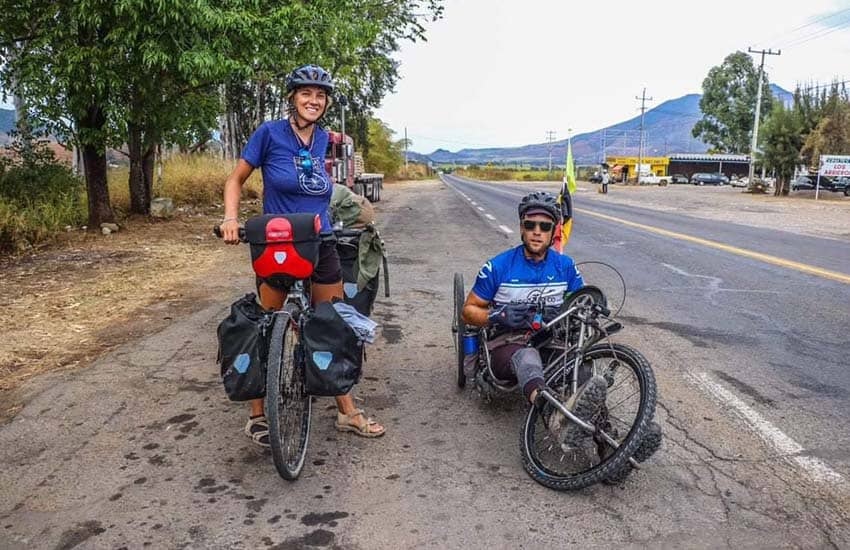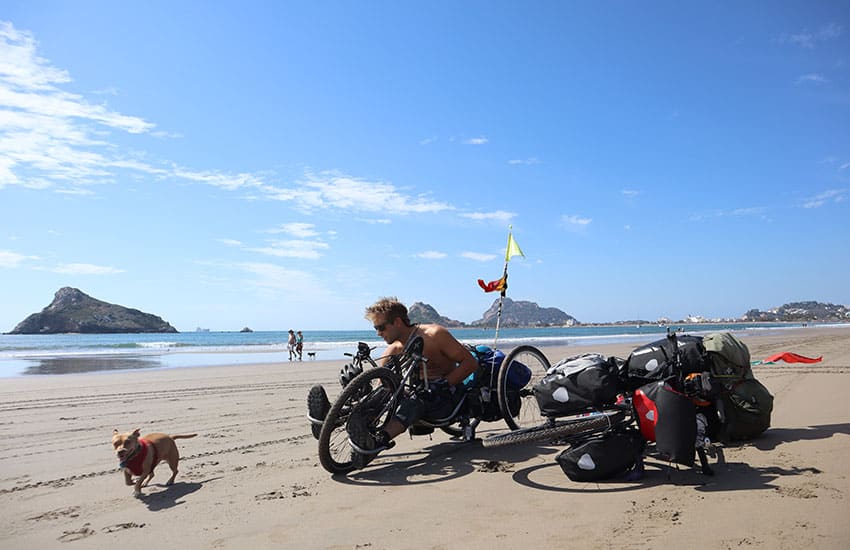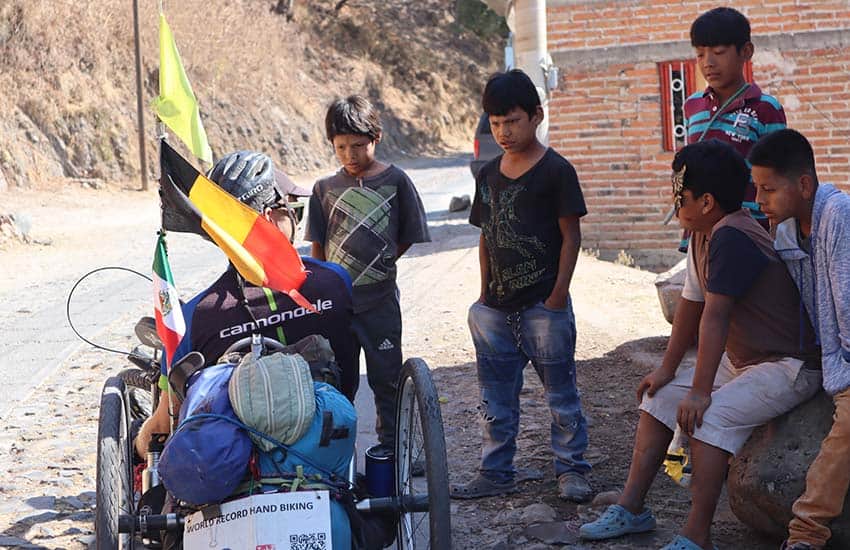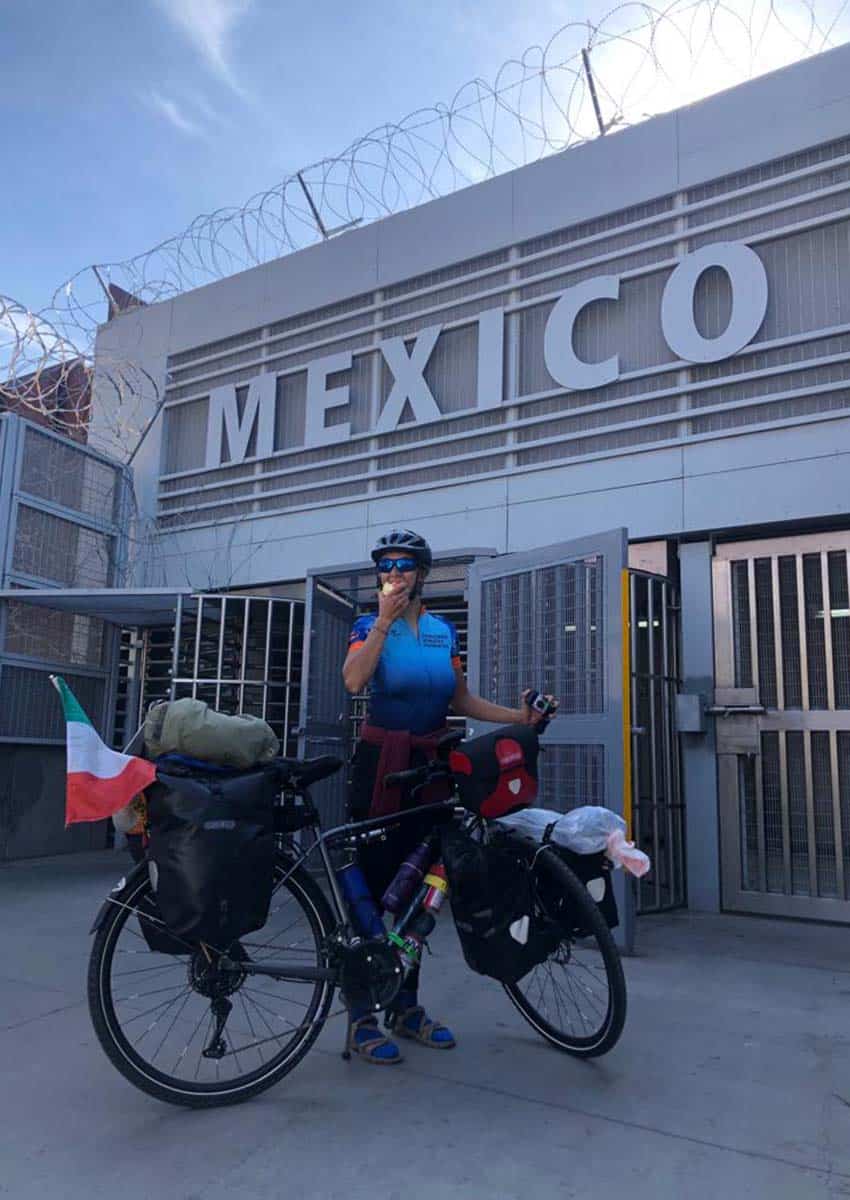Pair smashes Guinness record for distance handbiking in Mexico

European bikepackers Michiel Desmet and Chiara Maffina have braved blazing sun, pouring rain and fierce winds to break the world’s record in distance traveled by handbike, but despite their exhaustion, they could not resist Mexico’s charms.
The pair recently made an 8,600-km journey together — he on a handbike and she on a conventional mountain bike carrying most of their gear — through the Baja Peninsula to help Desmet set a new Guinness World Record for distance handbiking.
Despite having already accomplished their goal, the pair are still in Mexico and have continued to ride through the country — through Sinaloa, Michoacán and the Yucatán Peninsula — deciding that they wanted to see more of the country and its people that greeted them at every turn with kindness, support and enthusiasm.
They will be in the country until March 24.
In 2013, avid traveler Desmet found his world in a tailspin when his bus in Thailand crashed and a spinal cord injury put him in a wheelchair.
“I had to reevaluate my whole life.” he said.
The Belgian needed to find some sense of his former freedom.
“That freedom came in the form of a handbike,” he said, which he found much faster and more travel-friendly than a wheelchair.
This led to the idea of breaking the world record for handbike riding.
He settled on a Alaska-to-California route, with the distance more than enough to break the former record of 5,421 km set in 2002.
“But I could not do it alone, nor did I want to,” he said.
Enter Italian-born Maffina. Also a traveler, she met Desmet in Portugal. Shortly afterward, Desmet proposed the Alaska-to-California trip, which she thought was crazy.
Nonetheless, the two agreed to a trip in which she would ride a conventional mountain bike alongside Desmet on his handbike, and they began preparations. Physical training was important, but the main issue was logistics.

First there was fundraising for basic expenses. They used crowdfunding sites and got grants from organizations such as the King Baudouin Foundation. Most importantly, they worked out the bare minimum necessities of food, camping equipment and medical supplies since Maffina would have to carry just about everything; the handbike had limited space.
The two left Anchorage in June 2022 under the name Vid Expedition. The original goal was 6,500 km, which would be easily attained before arriving at the Mexican border.
However, as they got to Oregon, they met bikepackers who recommended Mexico, especially Baja. One major attraction of Mexico for both Desmet and Maffina was that they were tired of Canada and the U.S., which they felt was too much like Europe.
So they crossed the Mexico-U.S. border at Ensenada and continued on, zigzagging the peninsula — San Felipe, Mulegé, etc., until they made it to La Paz. They smashed the record with 8,600 documentable kilometers but decided that enough was enough.
Yet, instead of ending the trip, they decided to focus on seeing Mexico, combining biking with buses and even hitchhiking.
Desmet’s and Maffina’s success is in no small part because of the generosity of locals, who have offered food, water and shelter in all three countries, but Mexico has been particularly generous, the pair said.

One of the first issues they faced in Mexico was the difficulty in getting the large quantity of catheters that Desmet needs. Unable to use legal channels, they met a Russian immigrant in La Paz that drove them to the border at Mexicali (and back) and asparagus harvesters who crossed illegally to get their package in Calexico, California. The Mazatlán ferry company waived their fare in exchange for a presentation at a rehabilitation center.
Once on the mainland, the two avoided main roads as much as possible. From Mazatlán to San Blas, they literally hugged the shoreline, riding on local roads and low tide-exposed beaches, negotiating with local fishermen to cross isolated rivers and coastal islands.
“We were often alone on the beach with just the birds,” says Desmet. “It was so beautiful.”
This meant that they spent a lot of time in local villages, attracting a lot of attention. Swarms of children would approach them and their bikes. Locals offered food and other support. When a part on Desmet’s bike broke, a local took them to Tequila, where a replacement was made.
In eastern Michoacán, a local man not only put them up in their home for the night but also insisted on taking them to see the monarch butterflies.
Although they stayed as much as possible with Warm Showers hosts (a volunteer support for bikepackers), in various places they needed to find somewhere to camp. One good bet has been with local parish churches, who allowed them to set up for the night on their grounds.

When I interviewed the couple, they were staying with a Warm Shower host, preparing for the last leg of their journey: a bus ride to Campeche, with a month to be spent riding around the Yucatán Peninsula to see what they can of the region before they fly back to Europe on March 24.
In the end, they estimate that they will have cycled about 10,000 km.
Despite warnings about Mexico being dangerous, Desmet and Maffina’s experience biking throughout the country has been extremely positive. They are full of stories about generous people who just want to be a small part of their adventure. They found the highly isolated areas in Baja very safe to camp as “…there was absolutely no one around to bother us.”
Maffina loved the lonely stretches of road in many places, but others were simply inadequate for cycling of any kind, and cycling at night was out of the question. Desmet recalls that he hit one of Mexico’s infamous “invisible” speed bumps, causing a shoe to fly off. It got stuck in his disk brake, causing smoke from the friction.
But that is nothing, the couple says, compared to the aggression they got from drivers in Oregon and California who would deliberately drive too close.
Would they come back to cycle Mexico again? Absolutely.
Almost all of the coverage about them so far has been about the trek north of the border, from cycling media outlets like Gear Junkie, Safe Travel Ride and the Belgian news media. They have a YouTube channel, an Instagram page and a Facebook page.
They still accept donations, needing help with video editing, especially the footage from Mexico. Those interested in helping financially can head to Patreon or to Go Get Funding.
Leigh Thelmadatter arrived in Mexico over 20 years ago and fell in love with the land and the culture in particular its handcrafts and art. She is the author of Mexican Cartonería: Paper, Paste and Fiesta (Schiffer 2019). Her culture column appears regularly on Mexico News Daily.
Source: Mexico News Daily

